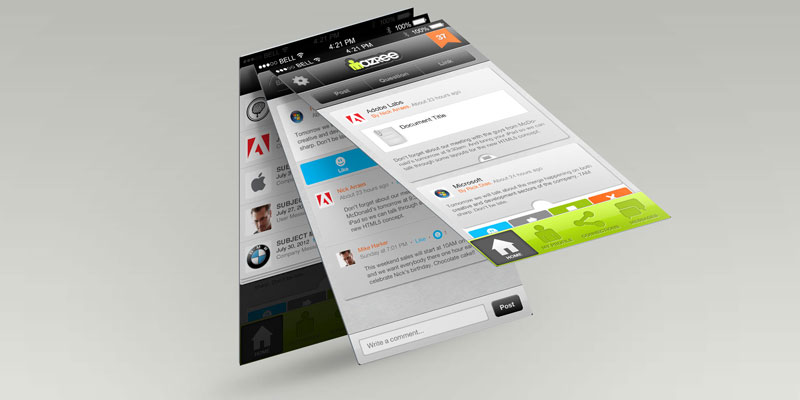As we embark on a digital revolution, the demand for captivating and accessible websites has never been higher. From smartphones to tablets, and now wearable gadgets, the way we interact with the digital realm is rapidly evolving. In this fast-paced world of technology, adapting to change is the key to survival. Enter responsive design – the superhero of web development. With its ability to seamlessly adapt and transform websites across various screen sizes and devices, responsive design has become the driving force behind captivating user experiences. In this article, we delve into the importance of responsive design and unravel its secret powers in delivering immersive digital journeys. So, fasten your seatbelts and join us on this transformative journey into the realm of responsive design!

The Key Benefits of Responsive Design for Websites
Responsive design is not just a trendy buzzword in the world of web development, but a game-changer with numerous benefits. One of the key advantages is enhanced user experience. With responsive design, websites adapt seamlessly to any screen size, ensuring that users can access and navigate them effortlessly on their smartphones, tablets, or desktop computers. This flexibility eliminates the frustration of zooming in and out or scrolling horizontally, creating a smooth and enjoyable browsing experience for all visitors.
Another significant benefit of responsive design is improved SEO performance. Search engines prioritize websites that are mobile-friendly, leading to better rankings in search results. By implementing responsive design, your website is more likely to be listed higher in search engine rankings, attracting more organic traffic and potential customers. As a result, your website’s visibility and overall online presence are amplified, helping you reach a wider audience. Additionally, a responsive design contributes to reduced bounce rates and increased conversion rates, as users are more likely to stay on your website and engage with your content when it’s easily accessible and visually appealing across various devices.

Common Challenges with Non-Responsive Websites
When it comes to non-responsive websites, the struggles can be as frustrating as trying to fit a square peg into a round hole. These outdated sites may have once served their purpose, but with the world going mobile, they come with a plethora of challenges. Let’s dive into some of the common obstacles faced by non-responsive websites:
- Decreased Mobile Traffic: As smartphones and tablets become ubiquitous, users are increasingly accessing the internet on the go. Non-responsive websites struggle to adapt to different screen sizes and resolutions, resulting in poor user experience on mobile devices. This limitation ultimately drives away potential traffic and hinders the growth of your online presence.
- SEO Nightmares: Search Engine Optimization (SEO) is the lifeline of any online business. However, non-responsive websites find themselves with lower search rankings due to their inability to provide optimized experiences across devices. Google’s algorithms now prioritize mobile-friendly websites, meaning non-responsive sites are left in the digital dust, struggling to keep up with competitors who have embraced responsive design.
So, whether it’s the loss of mobile traffic or sinking in SEO rankings, non-responsive websites face a variety of challenges in our ever-evolving digital landscape. It’s crucial for businesses to adapt to changing user expectations and ensure their websites can seamlessly adjust to any screen, big or small. The solution lies in embracing responsive design, where a website can effortlessly cater to the needs of desktop and mobile users alike.

Why Mobile-Friendly Design is Crucial for User Experience
In today’s digital era, where smartphones have become an integral part of our lives, ensuring a mobile-friendly design for your website has become more crucial than ever before. Not only does it enhance the user experience, but it also plays a significant role in capturing and retaining the attention of your audience.
A mobile-friendly design allows your website to adapt seamlessly to different screen sizes, ensuring that users can access your content and navigate through your site effortlessly, whether they are using a smartphone, tablet, or any other mobile device. With the increasing trend of browsing on the go, it has become imperative for businesses to prioritize mobile optimization to remain competitive in the online landscape.
Here are a few compelling reasons why a mobile-friendly design is indispensable for a superior user experience:
1. Improved Accessibility: A well-optimized mobile design makes your website accessible to a wider range of users, regardless of the device they use. By ensuring that your content is easily viewable and navigable, you extend your reach and make it convenient for users to engage with your website.
2. Enhanced User Engagement: When users have a seamless browsing experience on their mobile devices, it’s more likely that they will spend more time exploring your site and interacting with your content. This increased engagement not only boosts your conversion rates but also helps build strong, long-lasting connections with your audience.
Incorporating a mobile-friendly design is no longer just an option; it has become an essential aspect of successful web development and user experience. So, it’s time to embrace the power of responsive design and provide your users with an immersive mobile experience that keeps them coming back for more.

Best Practices to Implement Responsive Design Successfully
As technology continues to evolve, it is crucial for websites to adapt and cater to different devices and screen sizes. Responsive design has become the norm for creating user-friendly and visually appealing websites that seamlessly adjust to any device. Here are some best practices to successfully implement responsive design:
1. Mobile-first strategy: Start by designing for a mobile screen and gradually enhance the layout for larger screens. This approach ensures that the website is optimized for the increasingly dominant mobile usage.
2. Fluid grids and flexible images: Design your layout using a fluid grid system that automatically adjusts its components based on the screen size. Combine this with flexible images that scale proportionately, ensuring an optimal viewing experience across devices.
3. Simplify navigation: Mobile users often prefer simple and streamlined navigation. Avoid cluttering the screen with too many options or text-heavy menus. Utilize collapsible menus and intuitive icons for a smoother browsing experience.
4. Prioritize content: Content is king, regardless of the screen size. Ensure that your website’s content is easily readable and accessible on all devices. Prioritize key information and use appropriate fonts, font sizes, and spacing to enhance legibility.
5. Test across devices: Regularly test your website on various devices and screen sizes to identify any layout or functionality issues. Emulators and responsive design testing tools can help you simulate different devices and catch any potential glitches before they impact the user.
By implementing these best practices, you can create a responsive design that seamlessly adapts to various devices and screen sizes, providing an optimal user experience across the board. Remember, the key is to prioritize user-friendliness and accessibility while keeping up with the ever-changing landscape of technology.

Optimizing SEO and Conversion Rates through Responsive Web Design
Responsive web design is a crucial element in today’s digital landscape. It is not only about creating a visually appealing website, but also about optimizing its SEO and conversion rates. By embracing responsive web design techniques, businesses can ensure that their websites adapt effortlessly to different screen sizes and devices, providing a seamless user experience.
One of the key benefits of responsive web design is its positive impact on search engine optimization (SEO). A responsive website eliminates the need to create separate versions for desktop and mobile devices. This means that all traffic, regardless of the device being used, will be directed to a single URL, enhancing search engine visibility and avoiding the dilution of SEO efforts. Moreover, responsive design ensures that the website’s content is easily accessible, making it more likely to be indexed by search engines and increasing organic traffic. By incorporating effective SEO practices into a responsive design, businesses can improve their online visibility and drive more targeted traffic to their websites.
In addition to optimizing SEO, responsive web design also plays a crucial role in improving conversion rates. A responsive website provides a consistent and user-friendly experience across multiple devices, eliminating the need for users to zoom, scroll sideways, or wait for long loading times. This seamless experience creates a positive first impression and enhances user engagement, which in turn leads to higher conversion rates. With a responsive design, businesses can enhance their call-to-action buttons, optimize form fields, and create a streamlined checkout process that is optimized for different devices. By providing a frictionless user experience, businesses can increase conversions and ultimately drive more sales or achieve their desired goals.
Closing Remarks
In a world where technology has become an integral part of our daily lives, it is only fitting that our digital experiences adapt seamlessly to our every whim. Enter responsive design, the game-changing concept that has revolutionized the way we interact with websites and applications. But how important is responsive design, really?
Well, imagine a digital universe where websites remain frozen in time, frozen in their rigid desktop form. Picture having to zoom in and clumsily navigate through a page on your mobile device, desperately trying to read that tiny text or fumbling with buttons that seem to have shrunken into oblivion. It’s frustrating, isn’t it? A user’s experience takes a nosedive, leaving them exasperated and likely to abandon ship faster than you can hit the back button.
Responsive design swoops in as the hero of this tale, rescuing users from the depths of design despair. It effortless adapts and morphs to fit any screen, whether it be a massive desktop monitor, a sleek laptop, or the compact elegance of a smartphone. Suddenly, the user is greeted with a harmonious experience, where every element is perfectly proportioned, every piece of content is legible, and every button is easily tappable.
But it goes beyond mere aesthetics. Responsive design ensures that your website or application is ready to embrace the myriad of screens that users embrace in their day-to-day lives. With the proliferation of mobile devices, people are accessing the internet from an ever-expanding array of gadgets, and failing to meet their expectations can be a death sentence for your digital presence.
With a responsive design, you conquer the ever-shifting landscape of technology, future-proofing your creation against the winds of change. Who knows what tomorrow’s devices will look like? Will screens stretch, fold, or curve? It matters little when you have embraced the versatility of responsive design.
So, how important is responsive design? It is the bedrock upon which successful digital experiences are built. It is the harmony between technology and the user, a marriage that ensures every encounter is smooth, seamless, and delightful. It is the key to captivating and retaining the attention of a global audience, eager for innovation and sophistication.
Embrace responsive design, and unlock the infinite possibilities that lie at your fingertips. Your users will thank you, your digital presence will flourish, and you will become the master of the ever-evolving digital realm.
These days, websites are accessed on a variety of devices, from smartphones and tablets to desktops and laptops. This means the way content is displayed on different devices is becoming increasingly important. Responsive design is a way of addressing this issue, and it’s becoming increasingly essential to successful website design.
Responsive design is an approach to website design that ensures the content looks good on all devices. This means the website adapts to the size of the user’s device so the content is displayed properly, regardless of whether it’s viewed on a desktop computer, a smartphone, or a tablet.
At its most basic level, responsive design means allowing for different layouts for different screen sizes. This includes rearranging page elements, such as a menu, so it takes up less space on a smaller screen or changing the display of images to fit the device better. The website also needs to function properly at different screen sizes, which means content needs to load quickly and navigation should be easy.
Responsive design also offers the advantage of creating a unified experience for users regardless of the device they’re using. A website designed responsively will look and function the same regardless of the user’s device. This consistency is important to maintain because it ensures users are familiar with the website regardless of the device they’re using.
Finally, and perhaps most importantly, responsive design can help a website rank better on search engines. Search engines have been known to take into account the mobile-friendliness of a website whenranking them, which means a poorly designed website could mean lost rankings and reduced traffic.
In conclusion, responsive design is no longer a “nice to have” feature of modern website design, it is a “must have” feature. Responsive design offers improved user experience, a unified experience across devices, and better search engine rankings, so no matter what type of website you’re designing, it’s essential to consider responsive design.






Good topic! #responsiveDesign
mixnitup: I’m looking forward to your thoughts!
Can’t wait to see what you have to say! #responsiveDesign